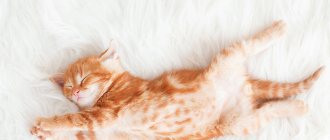(Be the first to vote!)
5589564
6 days ago owner reviews
As a parent, it is your responsibility to take the best possible care of your new pet. It is important that you have a good understanding of everything your pet needs to keep him happy and healthy. One of these must-haves is getting the right amount of sleep.
Cats—and especially kittens—have earned a reputation for their sleep patterns. You've probably heard talk about how many hours a day kittens sleep. You may even have questions about how much sleep your new kitten needs per day to maintain his well-being.
Today's topic of discussion is a complete guide to kitten sleep. First, let's look at the basics, namely how much sleep your new kitten needs. From there, read the discussion on why kittens need as much sleep as they need.
Then get some tips on how to adjust your kitten's sleep schedule and what to do if your kitten isn't sleeping enough. Finally, learn how to create the perfect place for your kitty to sleep.
- How much sleep does my new kitten need?
- Why does a kitten need to sleep so much?
- How do I get my kitten to sleep on a schedule?
- How to Create the Perfect Sleeping Place for Your Kitten
Physiology of cat sleep
Despite domestication, many cats have not lost the behavior and instincts of their wild nocturnal ancestors.
During the day, organs function slowly, and by night their functions are activated. Your pet will sleep during the day, but after a full dinner, it will definitely allow itself to relax at night, in a warm bed. A cat living on the street does not have this opportunity; it has to constantly get food and look for a secluded place to rest, which forces it to be active at night.
Three main factors influence sleep duration:
- Hormonal levels - depends on age, gender, fatness and health
- Nutrition and environmental factors - a hungry cat will never go to bed without being satisfied. Cold air temperatures and noisy environments will also not contribute to sound sleep.
- Psychological state - like people, cats are susceptible to stress and neurosis; in this state, sleep will be superficial and restless.
A cat sleeps 2 times longer than a human, at least 12 hours a day; it’s even better if the pet has the opportunity to rest for 14-16 hours. But our sleep phases are similar. Just like humans, felines have light sleep and deep sleep, these cycles repeat until they are interrupted by awakening.
The first phase of sleep lasts 10-40 minutes. A cat can doze in completely different positions, lying on its side, curled up in a ball, lying on its back or on its stomach, sometimes even sitting. During this period, metabolism, pulse and breathing slow down, but the muscles are not completely relaxed, the cat is ready to instantly react to changes in the situation.
The cat falls into the deep sleep phase for only 7-10 minutes. The muscles relax completely, although the brain, on the contrary, shows greater activity. The pupil moves under closed eyelids, the breathing and pulse rates are close to the active state.
During this period, the pet is defenseless, the reaction to external stimuli is very slow, and unscheduled awakening during this phase is not instantaneous, it lasts for 1-2 minutes. Like us, in this phase of sleep, cats dream and process information received during the day.
How to put a kitten to bed at night
Healthy and active kittens are often especially active at night. Because of this, the owner cannot get enough sleep due to the noise, and the kitten does not receive the necessary attention from a person who is tired during the day.
To avoid such difficulties, you need to teach the kitten to sleep at the appropriate hour. Animal psychologists recommend the following actions:
- Organization of a daily routine and strict adherence to it. Cats are socialized animals, so they need the attention and love of their owner. If possible, the owner should go to bed and get up at the same time. The cat will be able to get used to this regime, and will tend to fall asleep and wake up with the person.
- Create the same environment every evening. Cats thrive when they live on a consistent schedule. In addition, they remember well certain signs of the environment that accompany various activities of the owner. For example, if a person sleeps with the light turned off, then one must remember to turn it off at night. If the owner turns off the TV before going to bed, then this should always be done. Before going to bed, the environment should always be the same. It is through regularly repeated actions that the cat will begin to learn about the time for sleep.
- Feeding the kitten just before bed. All cats love to sleep after a hearty meal.
- Active games 20-30 minutes before bedtime. Evening games are a great way to burn off excess energy before going to bed. Ideal toys for a kitten would be toys that imitate running mice or flying birds, those that can bounce or dangle, and fishing rod toys. You need to play with the kitten until he gets tired and loses interest in games.
- Daytime entertainment. Kittens get bored sitting alone during the day when their owner goes to work. And if you provide him with toys and entertainment, then he most likely will not need the attention of his owner in the middle of the night.
It should be remembered that kittens need variety; they get tired of constantly playing with the same toy. Therefore, toys need to be changed periodically. It is not necessary to buy new ones, just hide them for a while so that the kitten has time to forget about them.
- Arranging a sleeping area. If the kitten knows that he has his own place to sleep, he will be less inclined to invade his owner's space. Kittens like a soft bed, the proximity of their favorite toys, close proximity to bowls of food and water, and a tray. If you arrange a kitten's sleeping place in accordance with its needs, then this is where it will go to sleep at night.
Before bed, you can hide toys with an attractive aroma and cat treats in various places around the house. Thus, the kitten will be able to search for prey at night, which will imitate its natural behavior in the wild.
It's not a good idea to use catnip to distract your kitten before bed. Many animals become more energetic and playful after consuming catnip, and some may even become aggressive.
If no advice helps train a kitten to sleep at night, this is a reason to be wary. Often, the reluctance to rest at the appropriate time is a way in which the pet tries to communicate that he is not feeling well. Therefore, if there are obvious sleep disturbances, the kitten should be shown to a veterinarian.
How long do cats sleep per day?
How much time does a cat spend sleeping? We have developed cheat sheets that will help you assess your pet's sleep health. Save it and periodically check your cat’s daily routine with our data.
| Cat (female) | Multiplicity per day | Hours per day | % from life |
| Adult cat (over 6 months) | 3 - 6 times | 12 - 15 hours | 50 — 65% |
| Older cat (over 10 years old) | 2 - 4 times | 14 - 18 hours | 60 — 75% |
| Neutered adult cat | 2 - 6 times | 13 - 16 hours | 55 — 70 % |
In what cases is long, constant sleep a sign of illness?
An animal's long sleep in itself should not cause concern to owners. You should be wary if, in addition to the constant need for rest, the cat also shows other signs of illness:
- refuses water and food, quickly losing weight;
- during short periods of wakefulness, visits the litter box too often;
- suffers from elevated temperature (the reason to measure it is a dry and rough nose);
- stops caring for the coat, causing it to become dull and brittle.
Since none of the listed symptoms are specific, only a veterinarian can tell why the animal is feeling unwell. He will prescribe appropriate treatment, after which the kitten’s sleep problems will disappear, as well as other signs of the disease.
There is no need to postpone your trip to the clinic. Increased sleepiness may be a symptom of:
- helminthiasis and other invasions;
- bacterial or viral infection;
- inflammation of internal organs;
- development of a cancerous tumor.
How long do cats sleep?
How long do cats sleep per day? Gender does not greatly affect the duration of sleep in felines. To the greatest extent this is due to a different hormonal background.
Adult cats sleep a little less than cats, and after going on a spree, they devote a minimal amount of time to sleep. Castrated animals, on the contrary, are distinguished by laziness; they do not mind sleeping an extra couple of hours a day.
| Cat (male) | Multiplicity per day | Hours per day | % from life |
| Adult cat (over 6 months) | 4 - 7 times | 12 - 14 hours | 50 — 60 % |
| Elderly cat (over 10 years old) | 2 - 5 times | 14 - 20 hours | 60 — 80% |
Long sleep and its causes
There are several reasons for prolonged sleep. If they are not associated with general lethargy and refusal to eat, then they are considered normal.
Cats are naturally very active. It is vital for them to replenish their strength and sleep is the best medicine for this.
Again, returning to natural premises, it should be noted that in nature, cats are predators. Their main diet consists of food rich in proteins. Pets also eat mainly protein foods, which require a long time to digest.
After sterilization, your cat may sleep longer than usual.
How long do kittens sleep?
The duration of sleep in kittens is very different from that of adult animals. A newborn kitten has a very low hormonal level, as it grows it increases, and as it gets older it decreases again, which explains why kittens and older pets sleep a lot.
The biological clock of a newborn kitten is set to sleep around the clock, with breaks for food. As babies grow older, their activity increases, and by 4-5 months it corresponds to the activity of an adult cat.
| Kittens | Multiplicity per day | Hours per day | % from life |
| Newborn kitten | 7 - 10 times | 21 - 23 hours | 85 — 95 % |
| 1 month | 7 - 10 times | 19 - 21 hours | 80 — 85 % |
| 2 months | 6 - 9 times | 18 - 20 hours | 75-80% |
| 3-4 months | 6 - 9 times | 16 - 20 hours | 70-80% |
| 5-6 months | 5 - 8 times | 14 - 17 hours | 60 — 70% |
Alarm bells for drowsiness
By nature, cats are lazy and love to sleep. The pet's waking period does not last long. When an animal sleeps a lot, it does not mean that there is something wrong with it. However, if you experience the following symptoms in addition to drowsiness, you should contact your veterinarian:
- Lethargy and apathy, refusal of previously favorite games;
- Lack of appetite and reluctance to drink;
- Increased temperature, nose hot and dry to the touch;
- Pallor of the mucous membranes.
Do you like cats? Mur-mur-murNet
The effect of cat breed on sleep duration
Cat breed has a significant impact on behavior and sleep duration. This is due to different types of higher nervous activity and temperament. Thus, easily excitable pets (mainly Oriental, Asian and Siamese-Oriental breeds) sleep a couple of hours less than the average table values.
Phlegmatic - calm cat breeds (Persian, Maine Coon, Siberian, British, Scottish, etc.) can sleep several hours longer than average.
The duration of sleep reflects the health of the pet. A caring owner should regularly monitor the pet for such violations. They are often caused by discomfort or pain. It is especially important to monitor the sleep of newborns and growing kittens.
Long sleep: normal or pathological?
In general, only a veterinarian can make conclusions about a pet’s health. Perhaps the cat is sick, and sleep is a consequence of malaise, weakness and loss of strength.
A kitten, a small cat sleeps all the time and this is normal. Her sleep may be interrupted by short games and food. At the same time, during rest, he can twitch his paws and squeak quietly. Don't worry, these are signs of emotionality experienced during the day's events.
Experts believe that the number of hours a pet naps and sleeps is greatly influenced by weather conditions . Since thermoregulation is important for animals, in the summer, especially on hot days, the rest period may increase and it will seem that the cat is sleeping all day.
A combination of drowsiness and lack of appetite should alert you. Then you definitely need to take your pet to the vet.
In general, long-term sleep is normal for cats, as long as there are no obvious behavioral abnormalities or problems with appetite or bowel movements during wakefulness.
Continuous supervision
Despite the fact that the kittens move awkwardly for the first few days, they are quite capable of climbing over low sides, climbing either over each other or over crumpled rags, crawl into the most secluded corners of the apartment and hide there. Therefore, I replaced the basin in which I initially put the kittens with a cardboard box with high sides. For the first couple of weeks, a quite suitable den for kittens.
The first days I didn’t make a partition inside the box, but after a week I built it, as the kittens grew older, began to interfere with each other’s sleep, spinning around, looking for the cat, clinging to each other.
Regular feeding
While the kittens were lying in the above-mentioned basin, I found on the Internet that it is necessary to feed the orphans with a special cat's milk substitute, sold in veterinary pharmacies. But 10% cream and regular high-fat milk are also suitable; sometimes you need to add 0.5 liters of raw yolk and 4 teaspoons of granulated sugar. I immediately went to the store.
I used glass pharmacy vials from penicillin as bottles, and the rubber parts of ordinary pharmacy pipettes became the nipples. They calmly stretch onto the wide neck of the bubbles. But you need to immediately purchase about 20 pipettes. They are sometimes torn, sometimes lost, sometimes spoiled by the kittens’ rapidly growing teeth.
The milk needs to be heated, you can do it for 3-5 seconds in the microwave, check before feeding to see if it is too hot - in general, everything is the same as with human children. And, of course, you need to wash and dry the nipple pipettes and bubbles after each feeding. It is convenient to pour the daily portion of milk into a separate jar with a plastic lid, store the jar in the refrigerator, stick a 10 ml syringe with a needle into the lid, and use it to pour milk into the bottle through a hole in the nipple. And you can draw milk from a jar with a syringe without a needle. This is more convenient than aiming milk from a tetra pack or can into a narrow penicillin bottle, then pulling the pipette onto the filled bottle. The syringe and needle should also be washed regularly.
The volume of a kitten's serving increases from 10-20 ml of milk in the first week to 100 ml by 3-4 weeks; they set the frequency of feedings for themselves. By two weeks, the 10 ml penicillin bottle can be replaced with a larger volume bottle, for example, a 20 ml pharmaceutical bottle of bacteriophage, and by three weeks - a 100 ml bottle of alcohol, if the number of kittens is more than one. Kittens eat depending on the weather - sometimes every hour, sometimes every 3-4 hours in sleepy, cloudy weather. When they are full, they lean away from the nipple. At night, our kittens slept decently, giving me a rest from midnight until exactly 8-10 in the morning. Only on the first night they made me stay awake, eating every hour.
It is convenient to feed kittens in your arms, with their back facing you, holding them with one hand under their front legs and belly, and holding the bottle with the other. A hungry kitten will fiercely cling to the bottle, preventing itself from sucking on the nipple, so at the beginning of feeding you need to hold your paws, and then when the kitten is calmly sucking, let go, then he will wrap his paws around the bottle. Visually or on scales, monitor the growth of the babies, by a week the weight should double and reach about 250 g, at 2 weeks - about 400 g, per month about 600-700 g, at 2 months - about 1300 g, by 6-8 months it reaches the size of an adult cat . If the kitten is not gaining weight, is lethargic and weak, go to the vet immediately!
One and a half month old cats in the same box as in the previous picture. They learned to jump over the partition, so it was removed.
Eight month old cat in a box with a bottom the same size as a cardboard box.
At the age of 15-20 days, you can feed kittens with soaked dry food for kittens, a couple of crackers are enough, or natural food. We started with natural complementary foods, in mini quantities - rice, corn, buckwheat porridge, cottage cheese with sour cream, boiled chicken or beef. Our kittens refused to eat boiled vegetables. When the kittens were constipated for longer than 3 days, I gave them a little Vaseline oil (from a syringe into the mouth), and did mini-enemas with warm soapy water (a syringe lubricated with Vaseline oil). Around the age of one and a half months, we switched to dry food and canned food for kittens, since the kittens refused to eat natural food.
Tummy massage combined with hair and eye care
Under normal conditions, the mother cat licks all the kittens’ fur, eyes, and mouth, thereby not only cleaning them, but also massaging them. Massaging the tummies and perineal area is necessary so that the kitten relaxes and goes to the toilet. Without massage, he does not know how to regulate his muscles.
Orphans can be massaged with a barely damp cloth, and their eyes can be wiped with a damp cotton swab. The kitten itself will begin to wash itself in 20 - 25 days. Our kitten Moor (which we kept for ourselves, and gave the second one away at one and a half months) began to wash itself from the eighth day, and was captured on this day - for history.
The eight-day-old Moor washes his face for the first time.
In the first 2-3 days, the umbilical cord falls off, so during the first days the belly must be wiped especially carefully. The procedure should be done after each kitten wakes up, making them want to defecate. By 4 weeks, kittens can control their urges to go to the toilet, so litter box training can begin at this age. We started even earlier, at about 2 weeks, when the kittens’ eyes had just opened, so that the kittens could get used to the sight of the litter box and to the fact that the smell of the toilet should be located only in one limited place.
When we went to live in the country, we took the tray with us. Once the kittens have woken up, been carried to the litter box and had their tummies and perineal area massaged, and they know that they need to go to the toilet after sleep, the pleasant feeling of relief in the bladder and bowels is automatically remembered and associated with the litter box. In this way, we practically “led” the kittens to the toilet by the hand, so by the age of one and a half months, Moor began to go to the toilet on his own one day. I watched him for a couple of days, no mistakes happened. Of course, then there were a couple of mistakes, but I washed everything with soap, put the lid on with a few drops of vinegar, and Mavrik forgot that place.











